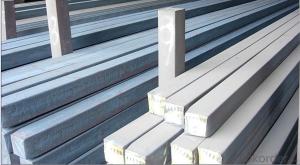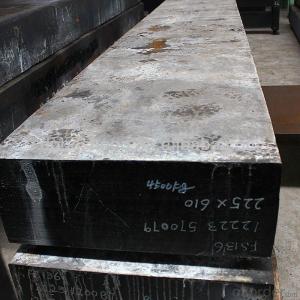Square Steel Billet Q235 Grade Prime Quality 4#
- Loading Port:
- Tianjin
- Payment Terms:
- TT OR LC
- Min Order Qty:
- 2000 m.t
- Supply Capability:
- 50000 m.t/month
OKorder Service Pledge
OKorder Financial Service
You Might Also Like
Description of Square Steel Billet Q235 Grade Prime Quality 4#
M. S. Billets are used for rolling of TMT Re-Bars of Fe415 and Fe500 Grade and various other structural steel products.
CRS Billets are used for rolling of CRS TMT Re-Bars.
Special Alloy Billets are used for rolling of any special grade TMT Re-Bars like Earthquake resistant TMT Re-Bars and for special grade structural steel products.
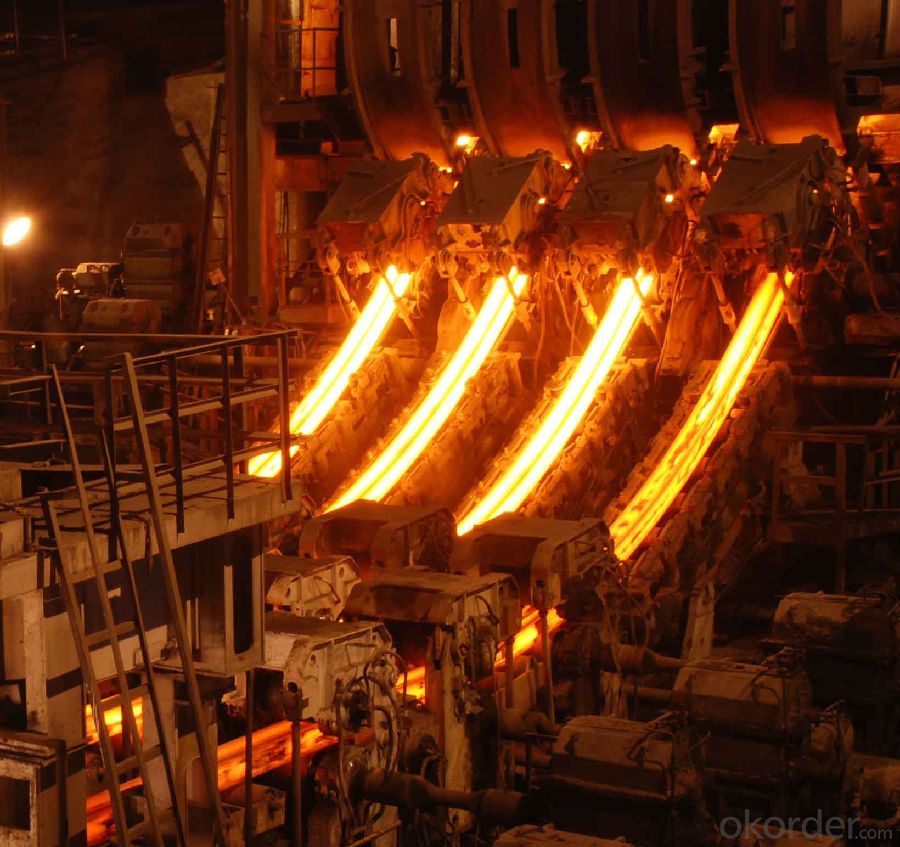
Main Feature Square Steel Billet Q235 Grade Prime Quality 4#
Raw elements(C,Fe,Ni,Mn,Cr,Cu.)---Smelted ingots by AOD finery---hot rolled into black suface---pickling in acid liquid---cold drawn----polished by automatically machine--- cutting into pieces---checking quanlity
Applications of Square Steel Billet Q235 Grade Prime Quality 4#
Widely Used in the areas such as Stainless Steel Fasteners, Chains, Kitchen and Sanitary wares, Furniture handles, Handrails, Electroplating and Electrolyzing pendants, Foods, Electron, Petroleum, Construction and Decoration, etc. Products have a high strength after cold-working. Electronic products parts, Medical appliance, Springs, Bus Inside and Outside packaging and building, Street Lamp Posts, etc. Decoration materials and Outdoor Publicity Billboard. Used for the products which have the Anti-Stress Corrosion requirement. Electron Products, Table-wares, Bolts, Nuts, Screen Meshes, Cumbustors and so on.
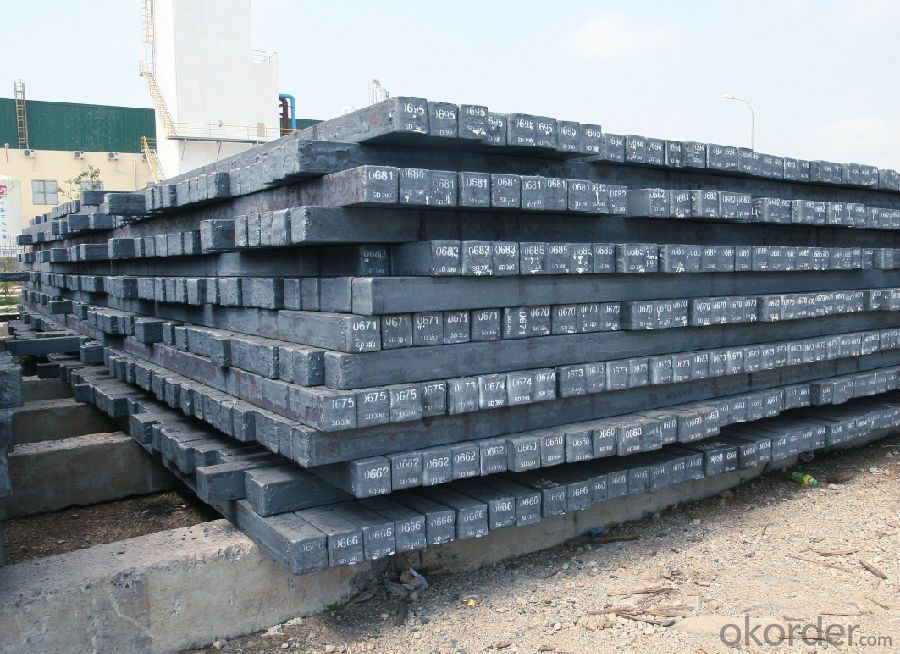
Specifications of Square Steel Billet Q235 Grade Prime Quality 4#
| Standard | C(%) | Mn(%) | S(%) | P(%) | Si(%) |
| Q195 | ≤0.12 | ≤0.50 | ≤0.040 | ≤0.035 | ≤0.30 |
| Q235 | ≤0.20 | ≤1.40 | ≤0.045 | ≤0.045 | ≤0.35 |
| Q275 | ≤0.22 | ≤1.50 | ≤0.045 | ≤0.045 | ≤0.35 |
| 20MnSi | 0.17-0.25 | 1.2-1.6 | ≤ 0.050 | ≤ 0.050 | 0.40-0.80 |
| 3SP | 0.14-0.22 | 0.40-0.85 | ≤ 0.050 | ≤ 0.040 | 0.05-0.15 |
| 5SP | 0.28-0.37 | 0.50-1.00 | ≤ 0.050 | ≤ 0.040 | 0.15-0.30 |
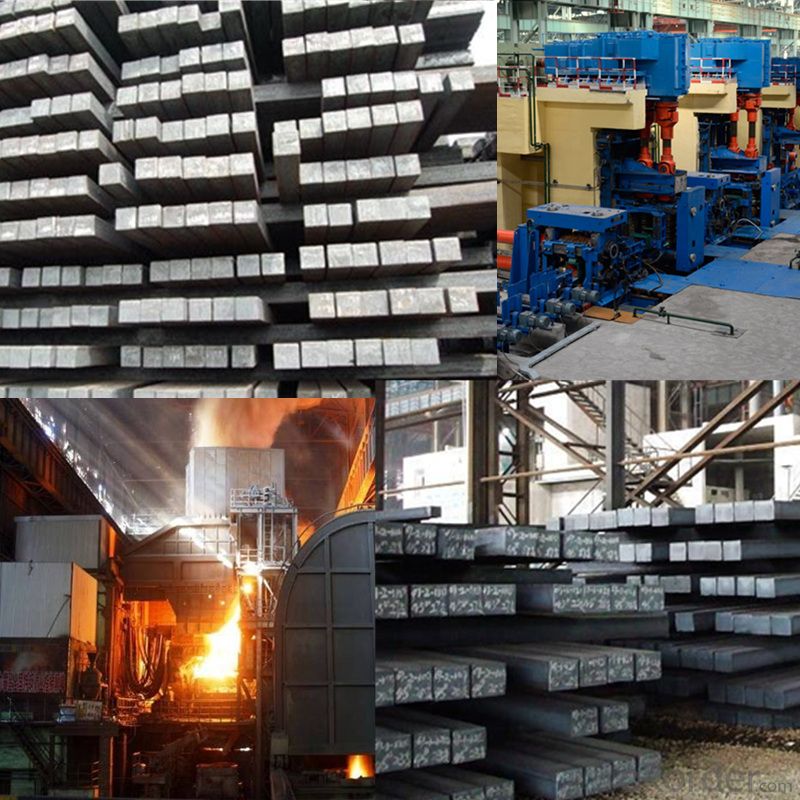
FAQ of Square Steel Billet Q235 Grade Prime Quality 4#
We have organized several common questions for our clients,may help you sincerely:
1. How Can I Visit There?
Our company is located in Tianjin City, China, near Beijing. You can fly to Tianjin Airport Directly. All our clients, from home or aboard, are warmly welcome to visit us!
2. How Can I Get Some Sample?
We are honored to offer you sample.
3. Why choose CNBM?
Our delivery time about 15-20days for standard sizes, if you have other requirements like hardness, quanity and width ,it is about 20-40days. But don't worry we also try our best for the delivery time ,because time longer and our cost is higher.
- Q:What are the main factors affecting the thermal conductivity of steel billets?
- The thermal conductivity of steel billets is influenced primarily by several factors. Firstly, the chemical composition of the steel plays a crucial role in determining its thermal conductivity. Elements like carbon, manganese, and silicon can impact the crystal structure and atom arrangement within the steel, thereby affecting its ability to conduct heat. Generally, steels with higher carbon content have lower thermal conductivity due to increased impurities and non-conductive carbide formation. Secondly, the microstructure of the steel also affects its thermal conductivity. Heat conduction in steel happens through lattice vibrations called phonons. Grain boundaries, dislocations, and other defects within the microstructure can hinder phonon movement, resulting in reduced thermal conductivity. Conversely, a more uniform and fine-grained microstructure enhances thermal conductivity. Furthermore, the temperature of the steel billet significantly impacts its thermal conductivity. As the temperature rises, the thermal conductivity of steel generally decreases due to increased scattering of phonons by lattice vibrations and higher thermal resistance. Another factor influencing the thermal conductivity of steel billets is their physical dimensions, specifically cross-sectional area and length. A larger cross-sectional area leads to higher thermal conductivity as there is more space for heat transfer. Similarly, longer billets tend to have lower thermal conductivity due to increased distance for heat conduction. Lastly, the presence of impurities and alloying elements in the steel can also affect its thermal conductivity. For instance, alloying elements like nickel, chromium, and copper can alter the crystal structure and lattice vibrations, thereby influencing the thermal conductivity of the steel billet. In conclusion, the thermal conductivity of steel billets is influenced by factors such as chemical composition, microstructure, temperature, physical dimensions, and the presence of impurities and alloying elements. Understanding these factors is crucial in various industrial applications where heat transfer and thermal management are critical.
- Q:What is the role of steel billets in the construction of high-rise buildings?
- Steel billets play a vital role in the construction of tall buildings, serving as the raw material for structural components like beams, columns, and girders. Their exceptional strength and durability make them ideal for supporting heavy loads and resisting external forces such as wind and earthquakes. Furthermore, steel billets offer design and construction flexibility, allowing architects and engineers to create intricate and visually appealing structures. Their versatility also enables the construction of large spans, reducing the need for excessive supporting columns and maximizing usable space. In addition, steel billets are highly resistant to corrosion and fire, ensuring the longevity and safety of skyscrapers. The galvanized or coated surface protects against rust, while the fire-resistant properties of steel maintain its strength at high temperatures. Moreover, steel billets contribute to the sustainability and environmental efficiency of high-rise construction. The use of recycled steel billets reduces the demand for virgin resources and minimizes waste, aligning with sustainable development principles. In conclusion, steel billets are crucial for constructing tall buildings due to their strength, durability, flexibility, resistance to corrosion and fire, and contribution to sustainable development. They enable the creation of robust, safe, and aesthetically pleasing structures that can withstand various forces and optimize space utilization.
- Q:What are the main factors that influence the strength of steel billets?
- The main factors that influence the strength of steel billets are the chemical composition, heat treatment, and microstructure of the steel. The chemical composition of steel billets plays a significant role in determining their strength. The presence of alloying elements such as carbon, manganese, silicon, and chromium can enhance the strength of steel by forming solid solutions or precipitates that increase the hardness and tensile strength of the material. Additionally, controlling the impurity levels and ensuring the desired balance of alloying elements is crucial in achieving the desired strength properties. Heat treatment is another crucial factor that influences the strength of steel billets. The heat treatment process involves heating the steel to a specific temperature, followed by cooling at a controlled rate. This process can significantly affect the microstructure of the steel, which in turn impacts its strength. For instance, quenching and tempering can result in the formation of a desired microstructure, such as martensite or bainite, which enhances the strength and toughness of the steel. The microstructure of steel billets is a key factor in determining their strength. The arrangement of the crystal grains and the presence of various phases within the steel can greatly influence its mechanical properties. Fine-grained structures generally exhibit higher strength due to a greater number of grain boundaries, which inhibit dislocation movement and enhance strength. Additionally, the presence of specific microstructural features, such as precipitates or second-phase particles, can also contribute to the strength of steel billets. Furthermore, factors such as the manufacturing process, cooling rate during solidification, and mechanical working (such as rolling or extrusion) can affect the strength of steel billets. These factors influence the grain size, grain boundary density, and defect concentration, all of which impact the mechanical properties of the steel. In summary, the strength of steel billets is influenced by the chemical composition, heat treatment, and microstructure of the steel. These factors can be carefully controlled and optimized to achieve the desired strength properties for various applications.
- Q:How are steel billets marked for identification and traceability?
- Steel billets are marked for identification and traceability using various methods. One common method is through the use of unique identification numbers or codes. These numbers or codes can be engraved or stamped onto the surface of the billet, making it easily identifiable. This marking can be done using specialized equipment such as laser engraving machines or steel stamping tools. In addition to identification numbers, other important information such as the grade, heat number, and production date can also be marked on the billet. This information is crucial for traceability purposes and helps in tracking the origin and quality of the steel. Furthermore, some manufacturers may opt to use additional marking techniques such as paint or ink marking. This can involve using specific colors or symbols to represent different characteristics or attributes of the billet. For instance, a specific color may indicate the steel's intended use or a symbol may represent the manufacturer's logo or quality certification. Overall, marking steel billets for identification and traceability is essential in ensuring quality control, verifying compliance with industry standards, and facilitating efficient inventory management throughout the supply chain.
- Q:How do steel billets differ from steel ingots?
- Steel billets and steel ingots are both intermediate forms of steel that are produced during the steel manufacturing process. However, there are some key differences between them. Firstly, the shape and size of steel billets and steel ingots differ. Steel billets are typically square or rectangular in shape, with a cross-sectional area of around 36 square inches. They are long and slender, usually measuring around 6 to 12 inches in width and 1 to 12 feet in length. On the other hand, steel ingots are generally larger and more irregular in shape. They can be cylindrical, rectangular, or even a combination of shapes, depending on the production method used. Steel ingots are usually much larger than billets, with a typical weight ranging from several tons to over 100 tons. Secondly, the production process for steel billets and steel ingots also differs. Steel billets are usually created through continuous casting, where molten steel is poured into a mold and then cooled and solidified to form a billet. This process allows for a more controlled and uniform shape, size, and composition of the billet. Steel ingots, on the other hand, are typically produced through ingot casting, where molten steel is poured into a large mold and left to solidify. This method is often used for larger steel ingots and allows for a more flexible and adaptable production process. Lastly, the purpose and usage of steel billets and steel ingots also vary. Steel billets are commonly used as raw material for further processing and shaping into various steel products, such as bars, rods, wire, and tubes. They serve as a starting point for the manufacturing of finished steel products. Steel ingots, on the other hand, are usually used for more specialized applications, such as the production of large steel components, forgings, or specialty alloys. Their larger size and irregular shape make them suitable for such demanding applications. In summary, steel billets and steel ingots differ in terms of their shape, size, production process, and usage. While steel billets are slender, square or rectangular in shape, and used as raw material for further processing, steel ingots are larger, more irregularly shaped, and often used for specialized applications.
- Q:What are the main challenges in the storage of steel billets?
- The main challenges in the storage of steel billets include the need for proper space allocation, adequate handling equipment, protection against corrosion and rust, and maintaining optimal temperature and humidity levels. Additionally, ensuring proper inventory management and efficient transportation of the billets can also be challenging.
- Q:What does "billet" mean?
- Steelmaking and continuous casting of steel products are mainly used for steel rolling, such as round bar, wire rod, sheet metal and so on
- Q:How are steel billets used in the production of wind turbine towers?
- Steel billets are used in the production of wind turbine towers as they serve as the primary raw material. These billets are heated and then shaped into the required cylindrical or conical form, which is essential for the structural integrity of the tower. The billets are then welded together to form the tower sections, which are further assembled and erected to support the wind turbine components.
- Q:How do steel billets contribute to the energy efficiency of a structure?
- Steel billets contribute to the energy efficiency of a structure by providing a strong and durable material that allows for the construction of lighter and more streamlined designs. The high strength-to-weight ratio of steel billets allows for the use of smaller structural elements, reducing the overall weight of the structure. This results in less material and energy needed for construction, as well as reduced transportation costs. Additionally, steel's thermal conductivity helps in the efficient transfer of heat, allowing for better insulation and energy conservation in the building.
- Q:What are the different types of cutting methods used for steel billets?
- There are several different types of cutting methods used for steel billets, including sawing, shearing, flame cutting, and water jet cutting.
1. Manufacturer Overview |
|
|---|---|
| Location | |
| Year Established | |
| Annual Output Value | |
| Main Markets | |
| Company Certifications | |
2. Manufacturer Certificates |
|
|---|---|
| a) Certification Name | |
| Range | |
| Reference | |
| Validity Period | |
3. Manufacturer Capability |
|
|---|---|
| a)Trade Capacity | |
| Nearest Port | |
| Export Percentage | |
| No.of Employees in Trade Department | |
| Language Spoken: | |
| b)Factory Information | |
| Factory Size: | |
| No. of Production Lines | |
| Contract Manufacturing | |
| Product Price Range | |
Send your message to us
Square Steel Billet Q235 Grade Prime Quality 4#
- Loading Port:
- Tianjin
- Payment Terms:
- TT OR LC
- Min Order Qty:
- 2000 m.t
- Supply Capability:
- 50000 m.t/month
OKorder Service Pledge
OKorder Financial Service
Similar products
New products
Hot products
Related keywords

